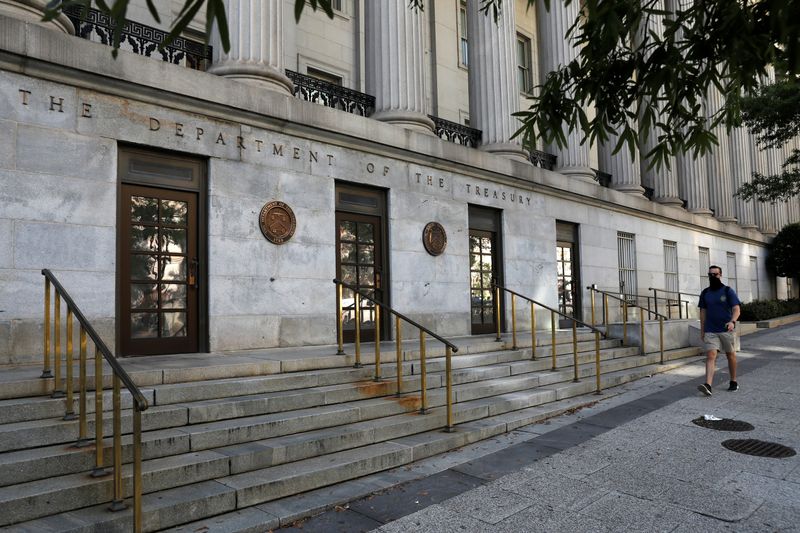By Karen Brettell
(Reuters) - The U.S. Treasury Department is likely to begin gradually increasing the size of its note and bond auctions when it announces its financing plans for the coming quarter next week, in order to finance higher spending as its tax revenues decline.
The Treasury has largely relied on sales of bills since the debt ceiling was suspended in June to replenish its cash holdings and fund its growing budget deficit.
But to keep the proportion of bills within the recommended range of its overall debt load, the government will also need to increase the size of coupon-bearing debt sales.
Some market participants had worried that a surge in Treasury bill issuance after the debt ceiling was temporarily lifted could adversely impact bank reserves and lead to tighter credit conditions, but these negative impacts have not materialized. The bills have seen strong demand from money fund investors.
Analysts said the Treasury’s note and bond auction increases are likely to be measured and should not disrupt the market either, with auction sizes holding below the peaks reached in 2020-2021, at least in the near-term. The government quickly ramped up issuance in 2020 to pay for COVID-19-related spending.
"It’s gradual," said Steven Zeng, U.S. rates strategist at Deutsche Bank (ETR:DBKGn). "I think the market’s not going to have any function issues."
WORSENING DEFICIT
The government is facing falling revenues as its outlays also increase. The Treasury earlier this month posted a $228 billion budget deficit for June, up 156% from a year earlier.
"Financing needs were higher in fiscal year 2023 than what I think many were anticipating," said Meghan Swiber, a rates strategist at Bank of America (NYSE:BAC).
"They have to grow coupon auction sizes - not just at the August refunding, not just at the November refunding, but also at the February refunding as well, because they are ultimately trying to balance this supply picture between bills vs coupons and this growing financing need," Swiber said.
The Treasury Borrowing Advisory Committee (TBAC) recommends that bills make up 15-20% of the total marketable debt. This ratio has grown to around 18% and analysts say it may briefly surpass the 20% level in fiscal year 2024, before coming back down.
Ben Jeffery, an interest rate strategist at BMO Capital Markets, notes that seven-year and 20-year auctions may be increased by less than other maturities. These issues suffered from relatively lower demand in 2020-2021 as they have a less established buyer base.
The Treasury will release its quarterly borrowing requirement Monday afternoon, and its refunding news comes Wednesday at 0830 ET/1230 GMT.
QT WILL INFLUENCE BORROWING NEED
BofA's Swiber added that the Federal Reserve's quantitative tightening (QT) program, in which it is letting bonds mature without replacement to shrink its balance sheet, is also likely to impact how much the Treasury will need to borrow.
"The longer that the Fed does QT, the more the Treasury ultimately needs to rely on the public to finance that," said Swiber.
The Treasury may also give an update on its plans to launch a buyback program, which is expected to begin in the first quarter of 2024.
The Treasury surveyed dealers about their opinion on how some details of the program should work ahead of the August refunding. The buybacks are meant to improve liquidity in the market by allowing Treasury to buy back less traded securities and issue more in the most liquid benchmark issues.
